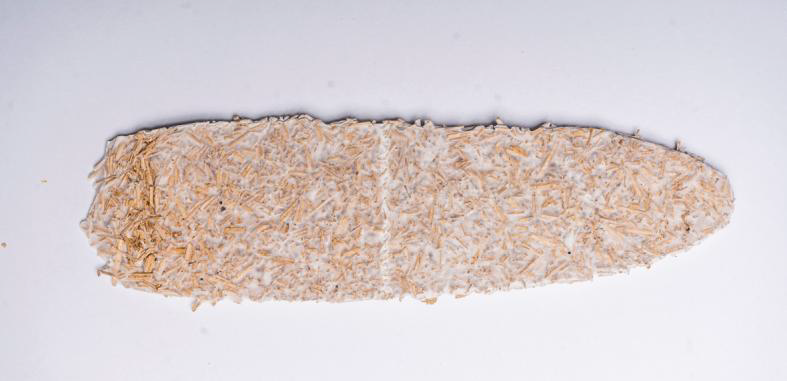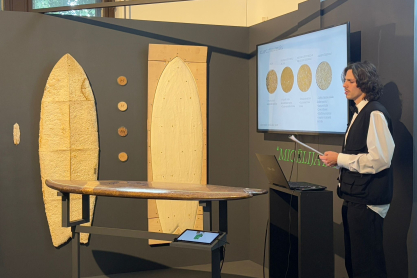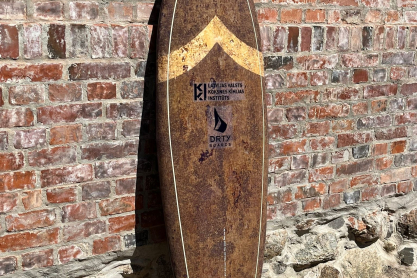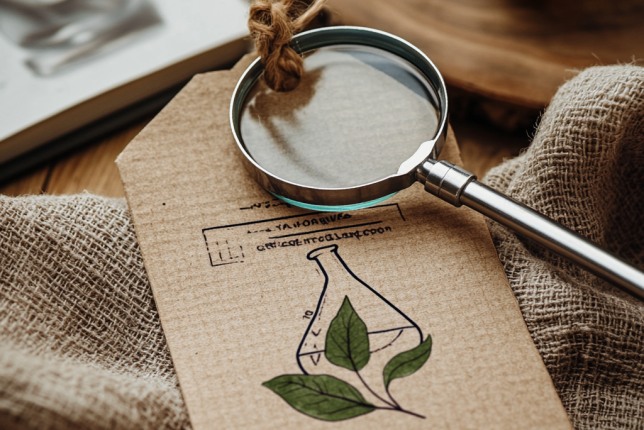Mycelium Surfboard: When Mushrooms Ride the Waves!

Yesterday, Lūkass Segliņš, an undergraduate student at the Art Academy of Latvia successfully defended his Bachelor’s thesis “The Mycelium Board” in the Product Design programme and received the highest possible grade – 10!
This is not just a visually striking surfboard – it’s an environmentally friendly biocomposite, grown from fungal mycelium in close collaboration with the Latvian State Institute of Wood Chemistry and Drty Boards surfboard craftsmen from Liepāja.
Scientists from LSIWC supported the development of a suitable mycelium composite material by testing a variety of substrates (oats, straw, buckwheat, bran, hemp) and evaluating mechanical properties. They also provided the laboratory equipment necessary for mycelium cultivation and drying. The result: a functional prototype that proves science and design together can create real alternatives to petroleum-based products.
The aim of the project was to develop a sustainable alternative to polyurethane foam, which dominates the surfboard industry. Lūkass chose mycelium as a binding agent and hemp fibres as reinforcement, resulting in a material that is biodegradable, sourced from local raw materials, and safe for humans.

Image 1. Hemp fibres
As the author himself points out:
The environmental impact of the surfing industry is surprising: around 750,000 surfboards are produced globally each year, and each board releases approximately 165 kg of CO₂ over its lifecycle – the equivalent of a car driving 700 kilometres.
This very fact became the starting point for Lūkass’s search for a sustainable solution.
The board was “grown” inside a custom-made mould, where mycelium slowly bound together around the fibres over several days. It was then dried at 70 °C to halt the growth process. For the lamination stage, Lūkass used bio-based epoxy resin and linen fabric, which provided the necessary strength.
The path to the final prototype was far from straightforward – it was an experiment involving time, fungi, and patience. To create a successful mycelium surfboard, Lūkass developed and tested a range of form factors and materials. He experimented with multiple substrates – evaluating both bonding quality and material structure.
Throughout the experiments, Lūkass observed that some fibres produced overly fragile or loose textures, while other substrates created too dense a structure or were mycologically unsuitable. Several test prototypes were made, starting from small 10x10 cm samples to larger slabs, until finally, a full-scale wooden mould for a real surfboard was constructed.

Image 2. First prototype

Image 3. Second prototype

Image 4. Third prototype

Image 5. Fourth prototype
One of the key challenges was ensuring uniform mycelium growth without compromising structural stability. The board was cultivated in controlled conditions and later dried at 70 °C to preserve mechanical strength while stopping fungal development.

Image 6. Ph.D. Mārtiņš Andžs working with mycelium in the mould
Throughout the process, collaboration with LSIWC researchers was crucial – not only for equipment access and expertise, but also for the trust and support that allowed the young designer to think and act like a scientist.

Image 7. Mycelium growth process
We congratulate Lūkass on this creative, research-driven, and forward-thinking achievement, and we are proud of the dedicated, human, and inspiring contribution made by the scientists at LSIWC to make this innovative project a success!

Special thanks to:
- Ph.D. Mārtiņš Andžs and Dr.biol. Ulla Milbreta, who not only shared their knowledge and lab resources but also generously gave their free time, evenings, and even weekends to help “grow” the idea into a full-fledged board;
- Dr.chem. Laura Andže, who readily stepped in, sourced key materials, and tirelessly supported the idea from beginning to end;
- and Dr.biol. Ilze Irbe – for the initial inspiration and opportunity to test early-stage material samples.





